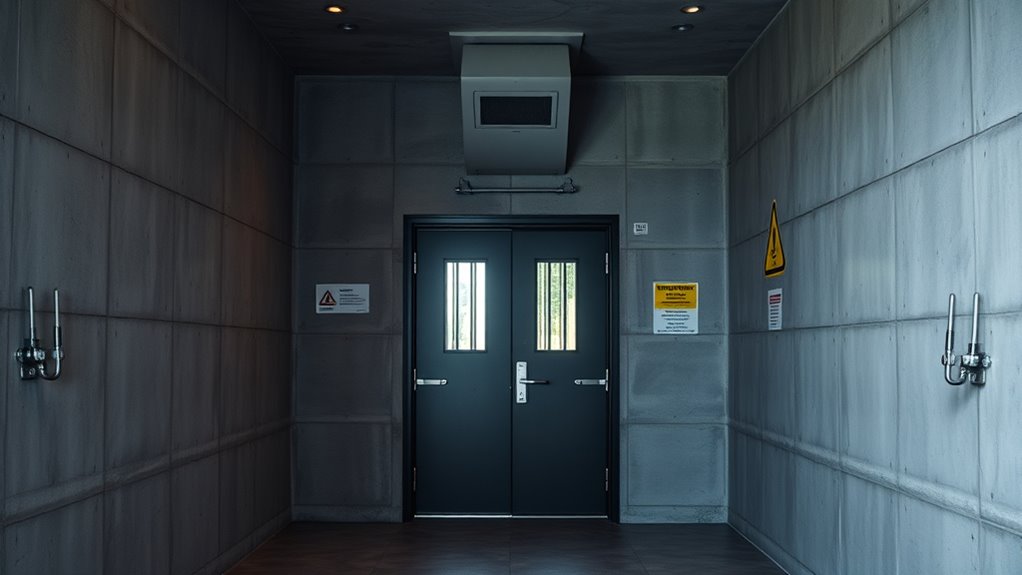To build an effective emergency storm shelter or safe room, you should choose durable, storm-resistant materials like reinforced concrete and impact-resistant doors and windows. Make sure to follow your local building codes, which specify minimum standards for safety and strength. Properly anchoring and reinforcing the foundation is essential to withstand high winds and debris. Pay attention to design details that enhance resilience. Keep in mind, understanding these vital factors will help you create a secure shelter—more tips await you as you continue.
Key Takeaways
- Use storm-resistant materials like reinforced concrete, steel, and impact-resistant doors to ensure durability against extreme weather.
- Comply with local building codes and obtain necessary permits to meet safety standards and legal requirements.
- Design a secure foundation with proper anchoring to withstand high winds, debris impact, and shifting.
- Incorporate industry standards and building regulations into the shelter’s construction for maximum safety and resilience.
- Consult professionals familiar with storm-resistant design to ensure proper construction, material selection, and code compliance.

When severe storms threaten your area, having a dedicated emergency shelter can be a lifesaver. It provides you with a safe haven where you can ride out dangerous weather events without fear. Building such a shelter requires careful planning, especially when it comes to selecting the right materials and complying with local building codes. Your goal is to create a structure that not only withstands high winds and flying debris but also meets all safety standards mandated by your community.
Start by choosing storm resistant materials that can endure the harshest conditions. Reinforced concrete, steel, and impact-resistant doors and windows are popular options because they provide superior protection against debris and strong winds. The walls should be thick and solid, offering a barrier against the force of a storm. If you’re considering a prefabricated shelter, check that it’s constructed from durable, storm-resistant materials recognized by industry standards. Remember, the quality of these materials directly influences the shelter’s ability to withstand extreme weather. Incorporating building standards into your planning can help ensure your shelter meets all safety requirements.
Choose storm-resistant materials like reinforced concrete, steel, and impact-resistant doors for maximum protection.
Next, it’s vital to familiarize yourself with local building codes. These regulations are in place to ensure safety and structural integrity and often specify minimum requirements for storm shelters, including wall thickness, anchoring methods, and ventilation. Before you start construction, contact local authorities to obtain the necessary permits and review the codes that apply to your area. Failing to adhere to these standards can lead to unsafe structures and potential legal issues, so it’s worth investing time in understanding and following them carefully. Additionally, understanding storm resistance can help you select materials that are more likely to perform well under extreme conditions.
Incorporating storm resistant materials in your shelter design isn’t just about durability; it’s about peace of mind. When you use materials that meet or exceed the standards set by your local building codes, you’re assured that your shelter will perform reliably during the worst of storms. Also, pay attention to the foundation, ensuring it’s secure and reinforced to prevent shifting or collapse. Proper anchoring is essential to keep the shelter stable against high winds and flying debris. Moreover, researching impact-resistant features can further enhance your shelter’s ability to withstand debris impact.
Additionally, understanding the importance of resilience can help you prepare emotionally and physically for storm events, making your shelter not just a structure but a true refuge during emergencies. It’s also beneficial to consult with professionals who are familiar with building codes to ensure your shelter complies with all safety standards. Ultimately, building an emergency storm shelter isn’t just a DIY project; it’s an investment in your safety. By selecting the right storm resistant materials and adhering to local building codes, you create a resilient structure that offers you and your loved ones protection when it’s needed most. It’s a proactive step that can make all the difference between safety and disaster during severe weather events.
Frequently Asked Questions
What Is the Average Cost of Constructing a Storm Shelter?
When you consider the cost of constructing a storm shelter, it’s important to factor in your budget planning and safety standards. On average, you might spend between $3,000 and $10,000, depending on size, materials, and features. You’ll want to choose options that meet safety standards while staying within your budget. Doing thorough research guarantees you get a durable, reliable shelter that keeps you safe during severe weather.
How Long Does It Take to Build a Safe Room?
Did you know that most safe rooms take about 3 to 4 weeks to build? Your construction timeline depends on factors like size, materials, and design considerations. If you’re planning a custom safe room, allow extra time for permits and inspections. Efficient planning helps make certain your safe room is ready quickly, providing peace of mind when severe weather strikes. Proper preparation makes all the difference in your safety and comfort.
Are There Specific Materials Best for Storm Shelter Durability?
When choosing storm resistant materials, you’ll want options that guarantee durable construction and withstand severe weather. Reinforced concrete, steel, and reinforced masonry are among the best for storm shelter durability. These materials resist high winds, flying debris, and water damage, providing safety and peace of mind. Prioritizing these sturdy options helps create a shelter that offers reliable protection during storms, giving you confidence your shelter will hold up under extreme conditions.
Can a Storm Shelter Be Added to an Existing Home?
You can add a storm shelter to your existing home through careful home integration. It’s essential to contemplate design considerations like space, accessibility, and structural support to ensure safety and functionality. Consulting with professionals helps you plan effectively, ensuring the shelter blends seamlessly with your home’s layout. With proper planning, you’ll create a secure refuge without compromising your home’s aesthetic or structural integrity.
What Permits Are Required for Building an Emergency Shelter?
You’ll need to follow your local building codes and complete the permit process before starting construction. Check with your city or county building department to understand specific requirements. They’ll review your plans, guarantee safety standards are met, and issue necessary permits. This step is vital to make sure your emergency shelter complies with regulations and can be legally built, avoiding potential fines or issues during inspections.
Conclusion
Building a storm shelter saves lives—studies show that properly constructed safe rooms can reduce injury risk by up to 75%. By investing in your safety now, you’re better prepared for unexpected severe weather. Remember, storms can strike suddenly, and having a secure space can make all the difference. Don’t wait until it’s too late; taking action today guarantees you and your loved ones stay protected when it matters most.









